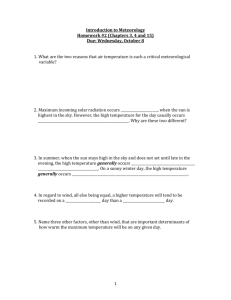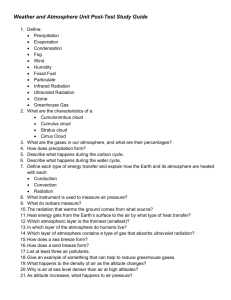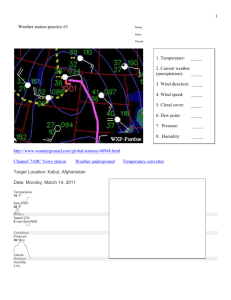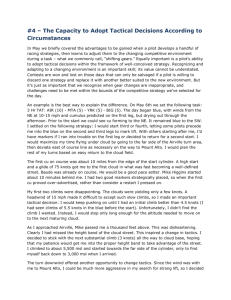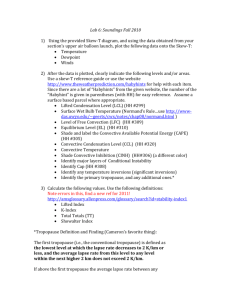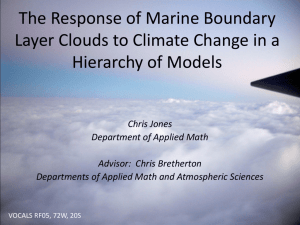Review sheet available here
advertisement
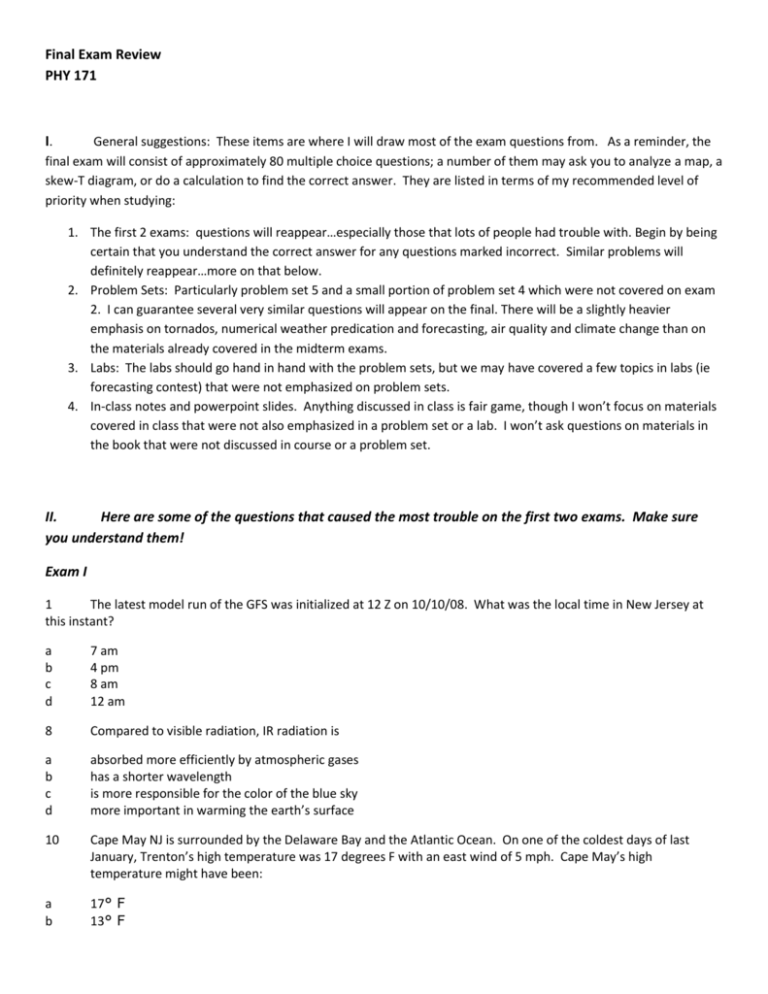
Final Exam Review PHY 171 I. General suggestions: These items are where I will draw most of the exam questions from. As a reminder, the final exam will consist of approximately 80 multiple choice questions; a number of them may ask you to analyze a map, a skew-T diagram, or do a calculation to find the correct answer. They are listed in terms of my recommended level of priority when studying: 1. The first 2 exams: questions will reappear…especially those that lots of people had trouble with. Begin by being certain that you understand the correct answer for any questions marked incorrect. Similar problems will definitely reappear…more on that below. 2. Problem Sets: Particularly problem set 5 and a small portion of problem set 4 which were not covered on exam 2. I can guarantee several very similar questions will appear on the final. There will be a slightly heavier emphasis on tornados, numerical weather predication and forecasting, air quaIity and climate change than on the materials already covered in the midterm exams. 3. Labs: The labs should go hand in hand with the problem sets, but we may have covered a few topics in labs (ie forecasting contest) that were not emphasized on problem sets. 4. In-class notes and powerpoint slides. Anything discussed in class is fair game, though I won’t focus on materials covered in class that were not also emphasized in a problem set or a lab. I won’t ask questions on materials in the book that were not discussed in course or a problem set. II. Here are some of the questions that caused the most trouble on the first two exams. Make sure you understand them! Exam I 1 The latest model run of the GFS was initialized at 12 Z on 10/10/08. What was the local time in New Jersey at this instant? a b c d 7 am 4 pm 8 am 12 am 8 Compared to visible radiation, IR radiation is a b c d absorbed more efficiently by atmospheric gases has a shorter wavelength is more responsible for the color of the blue sky more important in warming the earth’s surface 10 Cape May NJ is surrounded by the Delaware Bay and the Atlantic Ocean. On one of the coldest days of last January, Trenton’s high temperature was 17 degrees F with an east wind of 5 mph. Cape May’s high temperature might have been: a b 17° F 13° F c d 37 °F 58 °F 11 Which September night would be likely to have the coldest low temperature? a b c d humid and cloudy dry and partly cloudy dry and clear humid and partly cloudy 12 What solar elevation angle would be found at noon at TCNJ on Dec. 25? a b c d -23.5° 90° 28° 66.5° 13 The statistical peak in the Atlantic Hurricane season occurs near September 20 because: a b c d Clouds form more efficiently during equal periods of night and day Maximum tropical water temperatures occur at this time of year fueling storm development Tropical water temperatures have begun to cool down allowing more condensation Too much radiation intensity during June and July can inhibit storm formation 14 A cumulus cloud is more opaque than a cirrus cloud because a b c d It has a higher density of raindrops Ice crystals are more transparent than raindrops Cumulus clouds contain a high concentration of small cloud droplets. A high altitude, solar radiation has more energy to penetrate the cirrus clouds 15 The formation of a cloud by mixing is possible because: a Air cools adiabatically during expansion at lower pressure b Mixing helps to break hydrogen bonds in water which results in more rapid condensation c The heat absorbed by solar radiation is enhanced by turbulent mixing, resulting in favorable conditions for cloud formation d The curvature of the vapor pressure-temperature function (Clausius-Clapeyron equation) allows mixing to result in saturated conditions. 17 The presence of many condensation nuclei will result in a b c d a cloud with many small droplets a cloud with fewer droplets, but bigger average size the prevention of cloud formation the prevention of haze-like pollution 18 An urban heat island would not be caused by a b Large albedos of man-made surfaces Emission of waste heat by fossil fuel burning c d Lack of vegetation in the urban setting Retention of thermal heat by the high heat capacities of concrete and asphalt 1. What is the approximate height and temperature at the top of the tropopause? 9&10. On the following graph of incoming and outgoing radiation, indicate the times where sunrise and sunset occur and where minimum and maximum daily temperatures are likely to occur. Exam 2. 7. A) B) C) D) Which of the following does not depend on the presence of supercooled water drops? Aircraft icing Freezing rain Riming The collision-coalescence process 9. If a convergence of wind is occurring near the tropopause, which statement is most accurate? A.) B.) C.) D.) Air can’t converge at high altitude Convergence aloft maintains low pressure and storminess near the surface The tropopause inversion forces converging air to sink resulting in clear skies and high pressure Convergence and the pressure gradient force will result in widespread severe storms 10. At what time of the year would instability directly over the Great Lakes likely be the greatest? A.) B.) C.) D.) November 21 February 30 August 18 May 27 3. Why can’t a radar usually “see” clouds, but can see raindrops? 6. When the atmosphere is in geostrophic balance what is the relationship between isobar lines and wind speed and direction? 7. Explain what causes high speed down-drafts in thunderstorms. 11. At what pressure, speed, and general direction do winds in the jet stream flow across the midlatitudes of the Northern Hemisphere during this time of year? III. Regarding problems or calculations, you may expect the following: 2 MC questions about unit conversion calculations (likely including 1 volumetric and 1 energy question) 3 MC questions about a Clausius-Clapeyron humidity calculation 3 MC questions about a skew-T interpretation 3 MC questions about a geostrophic wind calculation 6 MC questions about model output interpretation and forecasting The first 4 problems will not be substantially different from those on the first 2 exams. An example of the kind of questions that may be asked about model interpretation are given below: 1) The local day and time this model output image is representing is: 10 pm, Thursday 8 am, Friday 3 am, Friday 9:12 am, Friday 2) The wind conditions over NJ should be forecast to be: West wind at 20 mph East wind at 15 mph West wind at 10 mph East wind at 30 mph 3) The precipitation the model depicts as falling at this time over New York state is expected to be: Rain Sleet Snow None



